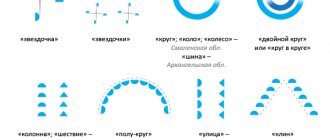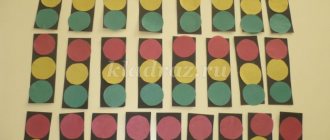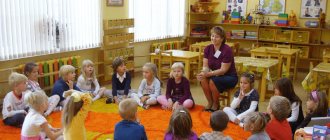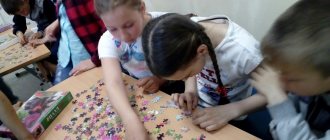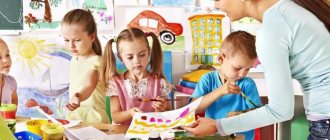Round dance game “Vanya Walks”
Progress of the meeting.
1. Introductory speech by the teacher.
Good evening, dear parents! Today we have an unusual meeting, but a gaming workshop. I invite you on a journey to the Land of Children's Games (I show a map of the Country) to learn a lot of new and useful things about children's games! But first, I suggest you analyze yourself, how you play with your children at home.
2. Ira - self-analysis “How we play with children at home”
Stand up, those of you...
1. who believes that play plays a very important role in a child’s life;
2. who knows what a role-playing game is;
3. who knows what role-playing games your child plays in kindergarten;
4. who has attributes (necessary items) for role-playing games at home;
5. who plays story games with the child at home;
6. who has printed board games at home;
7. who plays printed board games with their child at home;
8. who knows what didactic games are and why they are needed;
9. who plays didactic word games with the child at home or on the way to kindergarten and back;
10. who organizes children's parties at home with games for children;
11. Which of you likes to play in the company of friends and colleagues on holidays?
3. Mini-consultation for parents on the topic
“The role of play in the life of children 4–5 years old”
Children in the middle group clearly show interest in the game. Play activity is the leading activity at this age. Play continues to be the main form of organizing children's lives. Children participate in a variety of games throughout the day.
The importance of play in child development:
— mastering the rules of human communication;
- moral and volitional development of the child;
— personality education;
- obtaining new ideas about the world and oneself, new skills and abilities;
- mental development of the child: arbitrariness and purposefulness of behavior, ability to concentrate, creative imagination and fantasy, development of intelligence, transition from visual-effective thinking to elements of verbal-logical thinking; memory, speech;
- preparation for primary school age.
Conventionally, all games are divided into creative games and games with rules.
Creative games include role-playing games, theatrical games, round dance games, musical games, etc.
Games with rules are didactic and active games.
4. Traveling to the Land of Children's Games by boat.
While we are getting ready for the trip, someone should buy tickets on the ship for our friendly company. Who wants? (1 parent selected)
What do you need to fulfill this role? (wallet, money and passports)
Who will be the cashier at the transport agency? (1 parent is selected - cashier)
What do you need for this role? (signboard, window, money, tickets, cash register)
Selected parents select the attributes necessary for the game and act out the role-playing dialogue “Buying tickets at the box office.”
Tickets are bought. It's time to go on a journey.
Who will be the captain of the ship ?
(1 parent is selected - the captain; if there are no volunteers, the teacher takes on the role of captain of the ship)
What do you need to play? (binoculars, cap, map)
Who will be the sailor ? (1 parent is selected - sailor)
What do you need to play? (peakless cap)
Who will be the cook ? (1 parent is selected - cook)
What do you need to play? (cap, apron or robe, dishes, food)
Who will be the mechanic ? (1 parent is selected - mechanic)
What do you need to play? (tools)
Parents are selected for these roles.
Comrade captain and members of his crew, take your jobs and get to work.
Parents chosen for the proposed roles select the necessary attributes and take seats on the ship. Music is playing. The ship's captain gives commands. A sailor checks passengers' tickets. Parents - passengers are seated on the ship.
An episode of the game “Boarding a Ship” is played out.
Comrade captain, we have sailed to the city of role-playing games . Will you allow me to go ashore?
5. Mini-consultation for parents on the topic “Role-playing games in kindergarten and at home: meaning and diversity”
Role-playing game is a type of activity for children, during which children, in conditional imaginary situations, reproduce a certain sphere of activity and communication of adults in order to master the most important social roles and develop formal and informal communication skills. The basis of a role-playing game is an imaginary situation, which includes a plot , a role actions associated with it .
In the middle group, children play the following story games: “Family”, “Hospital”, “Kindergarten”, “Barbershop”, “Bus”, “Sailors”, “Zoo”, etc.
With the help of these games, children gain basic understanding of the work of adults, about objects that help people in different professions, learn to perform simple work actions, and build role-playing dialogues with each other. Story-based games help children learn the rules of behavior and communication between people in different situations.
Children come up with a plot for the game, distribute roles among themselves, select the items necessary for the game, arrange a place for the game and begin to play.
Play is a skill, and this skill needs to be taught to a child. At the age of 4-5, the main way of learning is joint play with an adult. Play together at home with your child! Buy him play sets for different story games or make them from scrap materials. Play not only with toys, but also with substitute objects. Let the child watch your play and then begin to act independently. Subsequently, you will only manage this game.
While we were walking on the island of role-playing games, the cook prepared us a delicious lunch.
The parent, in the role of cook, distributes lunch to the parents, the passengers, in plates.
An episode of the game “Lunch on a Ship” is played out.
Comrade captain, I was just in the hold of the ship. There's a leak there!
An episode of the game “Ship Repair” is played out.
Can I swim further? (No) I suggest continuing your journey through the land of games on another transport. Do you agree? (parents' answers)
6. Traveling through the Land of Children's Games by bus
Who can order bus tickets by phone?
The role-playing dialogue “Telephone Conversation” is played out.
Who will be the driver ? What will you need to play? (steering wheel)
Who will be the controller ? What will you need to play? (tickets and bag)
Take your seats on the bus!
The episode "Ride the Bus" plays out
Dear passengers, we are approaching the city of Theatrical Games
7. Mini-consultation “Theatrical games”
Theatrical play is the acting out of a certain literary work and displaying specific images using expressive methods (intonation, facial expressions, gestures).
The characteristic features of theatrical games are the literary or folklore basis of their content and the presence of spectators.
Theatrical play helps the child understand the moral implications of a literary or folklore work. In theatrical play, emotional development occurs: children get acquainted with the feelings and moods of the characters, master the ways of their external expression, and understand the reasons for this or that mood. With the help of theatrical play, children's dialogical and monologue speech and its expressiveness develop . Finally, theatrical play is a means of self-expression and self-realization for the child.
Theatrical games can be divided into two main groups: dramatization and director's.
In dramatization games, the child plays a role as an “artist” and independently creates an image using the means of verbal and non-verbal expressiveness. Types of dramatization are games that imitate images of animals, people, and literary characters; role-playing dialogues based on text; staging of works; staging performances based on one or more works; Improvisation games with playing out a ready-made plot (or several plots) without prior preparation
In director's play, “the actors are the toys or their substitutes, and the child, organizing the activity as a “scriptwriter and director,” controls the “artists.” “Voicing” the characters and commenting on the plot, he uses different means of verbal expression. The types of director's games are determined in accordance with the variety of theaters used in kindergarten: tabletop, flat and volumetric, puppet (bibabo, finger, puppets), etc.
I suggest everyone get off the bus and walk around the city of Theatrical Games.
Dear parents, please divide into 2 teams and complete the suggested tasks:
1 team – dramatization game based on the fairy tale “The Fox and the Gray Wolf” (masks and costume elements);
Team 2 – director’s play (parents choose the plot and puppets themselves)
The bus leaves further. We are approaching the city of Round Dance Games.
8. Mini-lecture “Round dance games”
Round dance games are a whole range of gaming exercises, including music, singing, free movements, poetry recitation, and pantomime.
Round dance games in kindergarten are simply necessary. Despite the apparent simplicity and the main game point, the importance of round dances is difficult to overestimate. They:
-develop a sense of rhythm and ear for music;
- help improve motor skills (from slow walking to running);
-facilitate the adaptation process: they bring children closer to each other, liberate them;
- teach children to act together and cooperate;
-introduce children to ancient traditions and customs.
Round dance game “Vanya Walks”
The bus leaves further. We are approaching the city of Construction and Construction Games.
9. Mini-lecture “Construction and construction games”
The basis of construction-constructive play is the activity of children, where they reflect the life around them in a variety of buildings using various materials and playful actions with them. Like any creative game, it has structural elements - motive, game design, roles, rules, game actions, result.
Construction games contribute to the development of a child’s creativity, thinking, and spatial imagination.
During these games, positive relationships between peers are formed. Typically, construction games are of a group or collective nature and therefore contribute to the development of mutual understanding, teach them to be attentive to other children, and communicate with peers and adults. In addition, children noticeably develop an interest in technology, they learn to finish a job they start, to see the result of collective work and its benefits. The concept and content of construction games contain one or another mental task, the solution of which requires preliminary thinking: what to do, what material is needed, in what sequence the construction should take place. This promotes the development of constructive thinking, the ability to create various models, and expands children’s knowledge about color, size, and shape.
In the process of construction-constructive games, the teacher teaches children to observe, distinguish, compare, remember and reproduce construction techniques, and focus on the sequence of actions. Children learn how to make a building, learn to plan the work, presenting it as a whole, analyze and synthesize the building, and show imagination.
During constructive games, preschoolers' vocabulary is enriched with the names of geometric bodies, adverbs expressing spatial relationships (high - low, right - left, up - down, long - short, etc.)
In kindergarten, children construct from various building materials:
-specially created (wooden, plastic, Lego)
-natural (sand, snow, clay, stones, etc.);
- waste (boards, boxes, boxes, etc.).
Please divide into 3 subgroups. You are invited to play construction games in subgroups on given topics using small toys
Card index of round dance games in the middle group
Transcript
1 Card index of round dance games in the middle group “Silence” Prepared by: teacher of the “Zvezdochki” Group Sinelnikova L.L. Goals: teaching children the ability to move in accordance with words; education of discipline. Content: the players walk in a circle with the words: “Silence by the pond, The water does not sway, The reeds do not make noise. Fall asleep, kids.” At the end of the words, the children stop, squat down and lower their heads. Stay in this position for 10 seconds. Anyone who moves leaves the game. The game is repeated until one child remains - the winner. Vanya is walking” Purpose: to teach standing in a circle, singing along to songs, and developing a friendly attitude towards each other. Vanya is walking. Vanya is walking, looking for Vanya, looking for Vanya, for himself, a friend. Found Vanya. Vanya found a little friend for himself. The children and the teacher stand in a circle. The teacher, and the children walk in a circle and say words. One child is in a circle and chooses a friend for himself with the words: I found Vanya, Vanya found a friend for himself. Standing in a circle, they dance, and the rest of the children clap their hands. Then the teacher changes the leader and the game continues.
2 “Flag” Purpose: to teach children to stand in a circle and perform actions, sing along to a song. Words: - children stood in a circle Movements: they saw a flag, To whom should you give, to whom should you give, To whom should you give the flag, come out, Sasha in the circle, Take Sasha the flag, the children stand in a circle, in the middle of the circle there is a flag. The teacher and the children walk in a circle and say the text. The child comes out according to the text, picks up the flag, then waves it and puts it back. Then the game continues “Bubble” Goal: teach children to stand in a circle and perform actions, sing along to a song. practice coordinating squats with words and pronouncing the words inflate a bubble, the sound sh-sh-sh. Inflate the bubble, inflate big Stay like that Don’t burst it flew, flew, flew Yes, it touched a twig shhhh. The bubble burst. Children and teacher stand in a circle. The teacher and the children walk in a circle and pronounce words until they say “The bubble burst.” Then they lower their hands and sit down, while pronouncing the sound sh-sh-sh.
3 “Bunny” Purpose: To teach to move in a circle, clap your hands. Bunny, bunny, why are you sitting still with you, stand up, jump, dance. your legs are good Movements: Children and teacher stand in a circle. The teacher and children walk in a circle and say sentences, while performing movements according to the text. “Cap” Purpose: to teach children to hold hands and perform movements according to the text of the game. Cap, cap, thin legs, red boots, we fed you, we gave you water, we put you on your feet, we made you dance. Children and teacher stand in a circle. The teacher chooses one of the children, he will be the cap. The teacher and the children walk in a circle and say sentences according to the text. When the words “we fed you, we gave you water” are said, the circle narrows, then again the children disperse back to form a large circle and clap their hands. A child standing in a circle dances. “We are nesting dolls” Purpose of the game: to teach how to perform movements according to the text, to show palms and boots.
4 Progress of the game. Children stand in a circle. The teacher and children walk in a circle and say: how about we have clean palms? and we, like we have new boots. and we, like we have new scarves. let's run. we all ran along the path. “Children and the Rooster” Goals: teaching children the ability to unconditionally and accurately follow the rules of the game. Children stand in a circle. One of the children stands in the center of the circle, depicting a rooster, they walk in a circle with the words: “Cockerel - cockerel, Golden comb, Oil head, Silk beard. Why are you getting up so early? Don’t you let the children sleep?” After these words, the children squat down and make “houses” with their hands above their heads. The “rooster” crows three times, the children scatter around the hall, and the “rooster” catches them. The first child caught becomes the "rooster"
5 “Entertainers” Goals: teaching children various dance movements; education of mindfulness. Children stand in a circle, with an entertainer in the center. Children walk in a circle with the words: “In an even circle, one after another, we go step by step. Stand still, together Let’s do it like this.” The children stop and the entertainer shows the movements. The children repeat it, the entertainer changes. Rule: movements should not be repeated. “Guess whose voice” Goals: Development of auditory perception, the ability to distinguish the voices of peers. One child stands in the center of the circle with his eyes closed. Children walk in a circle with the words: “We have gathered in an even circle, Let’s suddenly turn around at once, How about, let’s say: (says the first child) “Leap - hop - hop, guess whose voice?” The driver must recognize the child by his voice. The child whose voice is recognized becomes the driver. The children go in the other direction.
